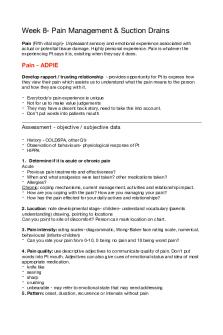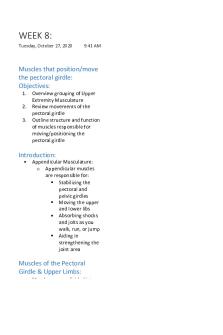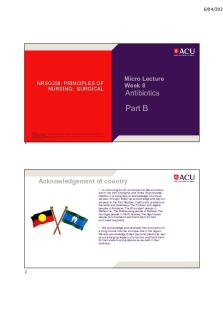NRSG 258 2021 Lecture Week 8 Part B antibiotics PDF

| Title | NRSG 258 2021 Lecture Week 8 Part B antibiotics |
|---|---|
| Author | rejina pandey |
| Course | Acute Care Nursing 1 |
| Institution | Australian Catholic University |
| Pages | 8 |
| File Size | 499.4 KB |
| File Type | |
| Total Downloads | 66 |
| Total Views | 171 |
Summary
notes...
Description
6/04/2021
NRSG258: PRINCIPLES OF NURSING: SURGICAL
Micro Lecture Week 8
Antibiotics
Part B
1
Acknowledgement of country • In continuing ACU’s commitment to Reconciliation and in line with Aboriginal and Torres Strait Islander tradition, it is customary to acknowledge country as we pass through. Today we acknowledge and pay our respects to the First Peoples, traditional custodians of the lands and waterways The Turrabul and Jagera peoples in Brisbane, The Wurundjeri people in Melbourne, The Wathaurong people of Ballarat, The Gurringai people in North Sydney, The Ngunnawal people from Canberra and thank them for their continued hospitality. • We acknowledge and celebrate the continuation of a living culture that has a unique role in this region. We also acknowledge Elders past and present as well as our emerging leaders of tomorrow and thank them for their wisdom and guidance as we walk in their footsteps.
2
1
6/04/2021
Sessi Session on Objec Objecttiv ives es – Ant Antib ib ibio io iottic icss • Review the basic structure of body cells (eukaryotes) and bacteria (prokaryotes) • Outline the basic principles of antimicrobial and antibacterial therapy and care considerations • Discuss infection control principles
3
His Histtory • Ancient Chinese used mouldy soybean on wounds • 340BC Chinese described a plant to reduce fever. Shown in 1971 to contain a compound effective against malaria • Early 1900s – Salvarsan (derivative of arsenic) which replaced mercury for the treatment of syphilis • Early 1930s – sulpha drugs • 1940s – widespread use of penicillin • Before antibiotics 30% of all deaths in the USA due to infection – TB, pneumonia, GI (Fair & Tor 2014) Antibiotic – substance produced by micro-organisms that kills or inhibits other microorganisms e.g. penicillin, tetracycline, vancomycin, gentamicin, cephalosporins Antibacterial – chemically modified antibiotic e.g. methicillin, amoxicillin or a synthetic drug e.g. sulpha drugs and quinolones
4
2
6/04/2021
Gene Genera ra ralise lise lised d hu hum man cell
Gene Genera ra ralise lise lised d ba bact ct cter er erial ial cell
Plasmids are small circular pieces of DNA outside the bacterial chromosome. They carry resistance genes for antibacterials and genes for toxins http://commons.wikimedia.org/wiki/File:Eukaryotic_Cell_(animal).jpg)
(http://en.wikipedia.org/wiki/File:Average_prokaryote_cell-_en.svg)
5
Com Comp pari rison son Eukaryotic (human) Cell
Prokaryotic (bacterial) cell
• DNA enclosed in a nucleus • Many linear chromosomes • Organelles with membranes e.g. endoplasmic reticulum,
• • • •
No nucleus Single circular chromosome No membrane bound organelles Cell membrane and cell wall
• • • •
Cell wall has peptidoglycan Divide by binary fission Ribosomes – protein synthesis Have plasmids
• Cell membrane but no cell wall in humans • No peptidoglycan • Divide by mitosis • Ribosomes - protein synthesis • No plasmids
6
3
6/04/2021
An Antib tib tibac ac actteria rials ls - selec selectiv tiv tive e to toxic xic xicit it ityy • Targets a difference between bacterial cells and human cells. Target sites include: – The bacterial cell wall – human cells do not have cell walls – Inhibiting bacterial enzyme pathways e.g. folic cid synthesis unique to bacteria – Disrupting bacterial protein synthesis – bacteria have different ribosomes to humans – Inhibiting bacterial DNA or RNA synthesis – drugs target bacterial enzymes
7
Sit Sites es of action - exam ample ple pless Inhibit cell wall synthesis – disrupt cell wall structure e.g. • Penicillins, cephalosporins and glycopeptides (Vancomycin, Teicoplanin) Inhibit protein synthesis – interfere with translation (DNA→ mRNA) or transcription (mRNA to protein E.g. binding to ribosomes) e.g. • Aminoglycosides (Gentamicin, Amikacin), tetracyclines, macrolides (Erythromycin) Inhibit nucleic acid (DNA or RNA) synthesis e.g. • E.g. sulfamethoxazole & trimethoprim (Bactrim) or metronidazole (Flagyl) Inhibit cell membrane function e.g. • Polymyxins (Colistin) (last resort for multi-drug resistant bacteria as nephrotoxic and neurotoxic as interact with human cell membranes also)
8
4
6/04/2021
Gr Gram am st stai ai ain n Classifies organisms on differences in their cell wall structure
Gram positive cocci
Gram negative cocci
(https://homepages.wmich.edu/~rossbach/bios312/LabProcedures/Gram%20Stain%20results.html)
9
Term ermin in ino olo logy gy Broad spectrum • Active against a wide range of micro-organisms e.g. Gram +ve and Gram -ve Narrow spectrum • Active against a narrow range of micro-organisms e.g. Gram +ve or Gram –ve or a few species only Bactericidal • Drug kills the organisms Bacteriostatic • Drug inhibits the growth of organisms Synergistic • Combined effect of the drug Antagonistic • Drug hindering the effect of another drug 10
5
6/04/2021
Term ermin in ino olo logy gy (c (co ont) Therapeutic Index (TI) • A narrow TI means there is little difference between the normal (therapeutic) dose and the toxic dose. Require monitoring of Liver and renal function as well as drug levels in the blood need close monitoring e.g. – vancomycin therapeutic range 5-15mcg/mL usually aiming for 1520mcg/mL, peak level above 20-40mcg/mL
11
An Anti ti tiba ba bact ct cter er eriial te test st sting ing One type is the antibiotic sensitivity test • Each disk impregnated with a different antibacterial in different concentrations and placed on a lawn of bacteria (creamy background) • If bacteria are resistant they grow up to the disk • If bacteria are sensitive the do not grow near the disk → zone of inhibition
(http://en.wikipedia.org/wiki/Antibiotic_resistance)
12
6
6/04/2021
References / Further Reading Bullock, S., & Hales, M. (2019). Principles of pathophysiology. Australia: Pearson. Bryant, B., & Knights, K. (2019). Pharmacology for health professionals (5th ed.). Australia: Elsevier. (Via Clinical Key) Antibacterial Drugs Ch37, 824- 841. https://www.clinicalkey.com.au/nursing/#!/content/book/3-s2.0-B9780729542753000372 Bullock, S., & Manias, E. (2017). Fundamentals of pharmacology (8th ed.) Sydney: Pearson Australia Centre for Disease Control and Prevention (CDC) Strategies for Implementing Antimicrobial Stewardship Guidelines. http: www.cdc.gov/drugresistance/healcare/ha/HAslideset/pdf Baranoski, Sharon, & Ayello, Elizabeth A. (2015). Wound care essentials : practice principles (Fourth edition.). Wolters Kluwer. Craft, J., Gordon, C. J., Huether, S. E., McCance, K. L., Brashers, V. L., & Rote, N. S. (2019). Understanding pathophysiology (3e, Australian and New Zealand edition.). Elsevier. Doughty, D. B., & Sparks, B. (2016). Wound-healing physiology and factors that affect the repair process. In C. Bryant & C. Nix (Eds.), Acute and Chronic Wounds (pp. 63-81). Fong, I. W., Shlaes, D., & Drlica, K. (2018). Antimicrobial Resistance in the 21st Century (2nd ed. 2018.). Springer International Publishing : Imprint: Springer. Lee, G., & Bishop, P.(2016). Microbiology & infection control for health professionals (6th ed.). Australia: Pearson. Letourneau, A.R. (2017). Beta-lactam antibiotics: Mechanisms of action and resistance and adverse effects. UpToDate. https://www.uptodate.com/contents/beta-lactam-antibiotics-mechanisms-of- action-and-resistance-and-adverseeffects?search=beta%20lactam%20antibiotics&source=search_result&select edTitle=1~150&usage_type=default&display_rank=1 Llewelyn, M.J., Fitzpatrick, J.M., Darwin, E., Tonkin-Crine, S., Gorton, C., Paul, J., Peto, T.E.A…Walker, A.S. (2017). The antibiotic course has had its day. British Medical Journal, 358:j3418.
13
References / Further Reading Manning, M.L., Pheiffer, J., & Larson, E.L. (2016). Combating antibiotic resistance: The role of nursing in antibiotic stewardship. American Journal of Infection Control, 44(17), 1454-1457. Martini, F., Ober, W. C., Welch, C. E., Hutchings, K., Welch, Kathleen, & Hutchings, R. T. (2018). Fundamentals of anatomy & physiology (11th ed., Global ed.). Pearson. Marieb, E. N., & Hoehn, K. (2019). Human anatomy & physiology (Eleventh edition, Global edition.). Pearson. Rothrock, J. C., & McEwen, D. R. (2019). Alexander's care of the patient in surgery (16th edition.). Elsevier.Tortora, G.J., Funke, B.R., & Case, C.L. (2016). Microbiology: An introduction (12th ed.). England: Pearson Education Ltd. Thomas Hess, C (2013) Clinical Guide to Skin & Wound Care (7th Ed) Philadelphia: Lipppincott William & Wilkins Williams, C.M., Maher, C.G., Latimer, J., McLachlan, A.J., Hancock, M., Day, R.O., & Chung-Wei, C.L. (2014). Efficacy of paracetamol for acute low-back pain: a double-blind, randomised controlled trial. The Lancet, 384 (9954), 1586-1596. World Health Organisation. [WHO]. (2017a). Guidelines for the prevention and control of carbapenem-resistant Enterobacteriaceae, Acinetobacter baumannii and Pseudomonas aeruginosa in health care facilities. http://www.who.int/infection-prevention/publications/guidelines-cre/en/ World Health Organisation. [WHO]. (2017b). Antibiotic resistance. http://www.who.int/mediacentre/factsheets/antibiotic-resistance/en/ World Health Organisation. [WHO]. (2015). Antibiotics: Handle With Care 2015 Campaign Toolkit. http://www.who.int/mediacentre/events/2015/world-antibiotic-awareness- week/waaw-toolkit.pdf?ua=1
14
7
6/04/2021
Questions?
15
8...
Similar Free PDFs

Week 8, Part 2 - Lecture notes 8
- 5 Pages

Week 1 notes part B - lecture 1b
- 9 Pages

Lecture 7 - part b
- 6 Pages

Trigger 2 258 week 1
- 4 Pages

Tutorial week 1 CHM 258
- 8 Pages

Lecture 2 DEF (part b)
- 13 Pages

Week 8 - Lecture notes 8
- 6 Pages

Week 8 - Lecture notes 8
- 23 Pages

WEEK 8 - Lecture notes 8
- 10 Pages

Week 8 - Lecture notes
- 3 Pages

Week 8 Lecture
- 51 Pages
Popular Institutions
- Tinajero National High School - Annex
- Politeknik Caltex Riau
- Yokohama City University
- SGT University
- University of Al-Qadisiyah
- Divine Word College of Vigan
- Techniek College Rotterdam
- Universidade de Santiago
- Universiti Teknologi MARA Cawangan Johor Kampus Pasir Gudang
- Poltekkes Kemenkes Yogyakarta
- Baguio City National High School
- Colegio san marcos
- preparatoria uno
- Centro de Bachillerato Tecnológico Industrial y de Servicios No. 107
- Dalian Maritime University
- Quang Trung Secondary School
- Colegio Tecnológico en Informática
- Corporación Regional de Educación Superior
- Grupo CEDVA
- Dar Al Uloom University
- Centro de Estudios Preuniversitarios de la Universidad Nacional de Ingeniería
- 上智大学
- Aakash International School, Nuna Majara
- San Felipe Neri Catholic School
- Kang Chiao International School - New Taipei City
- Misamis Occidental National High School
- Institución Educativa Escuela Normal Juan Ladrilleros
- Kolehiyo ng Pantukan
- Batanes State College
- Instituto Continental
- Sekolah Menengah Kejuruan Kesehatan Kaltara (Tarakan)
- Colegio de La Inmaculada Concepcion - Cebu




